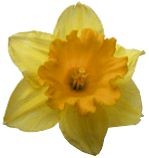|
______________________________________________________
Daffodil
Origins, Lore, and Traditions

Original
Illustration
by Cicely Mary Barker
While
it is easy to be infatuated with the colors, forms and
fragrances of the daffodil, a real relationship is built
upon knowledge of its origins, lore and traditions, as
well as its sentiment and symbolism. Just as
love among people is based on intimate knowledge, so too
for the daffodil lover.
The
following was gleaned from the Internet:
|
 |
Plant
lore tells us that daffodils bring good
fortune to the person who avoids trampling on
them, so watch where you step! |

The
daffodil is a symbol of rebirth - a sign of the
new beginnings that come with spring. Daffodils
are often found connected with Easter and Easter
religious services because of their new birth
significance.

Daffodils
are the birthday flower of March,
the same month as the spring equinox that
heralds the beginning of a new season.
|

|

|
Never
give a single daffodil, as bringing a single
daffodil into the house will bring misfortune.
Always
give a bunch to ensure happiness.
|

| In
Wales finding the first daffodil of spring is
expected to bring more gold than silver to your
life and home during the following 12 months.
|

|

|
The
daffodil is associated with Lent, the 40 days of
fasting and penitence before Easter Sunday in
most Christian churchesand is known as the "Lenten
Lilly" in England. There is a legend
that the daffodil first appeared on the night of
The Last Supper in the Garden of Gethsemane to
comfort Jesus in his hour of sorrow.

~
Courtesy, Danny Halborn, 1999
www.tribulation.com
|

|

|
Because
all the animals loved St. Francis, he was gifted
with a nest of colored eggs. His constant
companion, a rabbit, asked the daffodil for its
yellow color to color the lark's eggs; the
crocus, for its blue color; and the violet, for
its purple color. St. Francis was so pleased
with the gift that he said a basket of colored
eggs would return as an Easter gift forever, in
memory of the first Easter rabbit. |

| The
daffodil is the American
Cancer Society's symbol of new life and hope
that a cure for cancer will be found. "You
see a daffodil and know there's hope," says
Debbie Jaramillo, volunteer chair, California
Division Daffodil Days. "And with hope,
there's a cure. They're a burst of sunshine, a
ray of hope. Even if it is still cold outside,
you know there's warmth and light ahead."
You
can spread it with a hug.
You can catch it from a smile.
And you can celebrate it with a flower.
It's a miracle we call Hope.
~
Daffodil
Days, California
|
 |


|
Narcissus
(another name for the daffodil), meaning -
"narcissism", which comes from "narke,
" the Ancient Greek work for deep sleep,
stupor or numbness. Narke is also the root of
the word "narcotic."
The name is probably a reference to a toxic
paralyzing alkaloid contained within narcissi
bulbs. The good news is the bulbs taste just
awful, making it highly unlikely that anyone
could even keep down one bite.
|
| Roman
soldiers would carry several bulbs with them and
if mortally wounded, they'd chow down on the
bulbs. The bulb would work its narcotic
wonder and the soldier would painlessly die. |

|

|
According
to a Greek myth, a young wood nymph named Echo
fell in love with a young man named Narcissus.
He was bestowed with great beauty, by the gods.
He was given the gift of eternal youth and
beauty, provided he did not look at his own
reflection.
Self-absorbed, he spurned the affections of
Echo, who was consumed by love, until all that
was left of her was her voice. Because of
this sad affair, the daffodil signifies
unrequited love.
|
Nemesis,
the goddess of retribution and vengeance, led
the vain Narcissus to a shimmering mountain lake
that mirrored his face. There, at the water's
edge , he fell in love with his image and was
transfixed, caught in the spell of his beauty.
Every time he tried to touch the image it
disappeared in the ripples of water, so instead
he simply sat at the water's edge and stared
sadly at the reflection.
The "drooping" of the daffodil
symbolizes Narcissus admiring himself.
|

|
|
The
Gods thought that Narcissus would die of hunger
if he remained there any longer so they turned
him into a scented flower which, to this day
blossoms in the mountains in spring and which is
still called Narcissus.
Thus, the daffodil symbolizes unrequited love,
vanity and excessive self-love. The center of
the daffodil cup is said to contain the tears of
Narcissus.

|

| The
word "Daffodil" didn't come into the
English language until the 1500s. The old name
for daffodil was “Affodyle,” believed to
originate with the Old English “Affo dyle,”
meaning “that which cometh early.”
It ultimately
derived from Dutch de affodil meaning
"the asphodel"(of Greek mythology).
And it is in asphodel-covered meadows (Homer)
that the souls of the dead wandered, and thus
the Greek related the flower with death.
According to this legend it was here that Hades
captured Persephone after she had strayed from
her companions to pick some daffodils.
|
|

|
Persephone,
down in the land of the dead, wore a crown of
the flowers. She wore this crown for
" it is symbolic of the one flower (life)
that comes back in the spring, (often the first
'bulb' flower to do so besides snow crocus)
whose leaves while laying fallow in winter, have
actually fed the rhizome under the cold ground,
thereby " increasing the root" while
"looking dead." Persephone IS the
return of the light (sun's longer days that
signals that the time of seeming deadness is
over....) The little flower she bent down to cup
in the field was likely signalling that it
is time for the darkening, the underground time,
to begin." ~ pinkolaestes |

| Daffodils
are believed to have been brought to Britain by
the Romans, who mistakenly believed that its sap
could heal wounds. In fact, daffodil sap
contains sharp crystals that prevent animals
from eating the flower. While it did little to
heal the Romans' wounds, it succeeded in further
irritating their skin. |

| While
daffodils can be taken to say, "My fond
hopes have been dashed by your behavior,"
they mostly say, "You're the only one. The
sun is always shining when I'm with you."
As
a spring flower that blossoms when the sun
begins to shine, it
expresses the joy one has when in the presence
of one’s partner, signifying love,
regard, and respect.
|

|

 |
A
woman giving daffodils to a man has noticed
that he is chivalrous.
|

| A
lesser-known epithet when applied to soldiery
is to be called a daffodil. Apparently
this means that they are nice to look at but
yellow through and through.
This
term was apparently used by the British in
official correspondence during WWII, referring
to the "Australian daffodils"
that lost Singapore.
|
 |

|
Old
English folklore also discourages from
bringing daffodils into the house when poultry
are sitting on eggs.
They
believed they would stop their poultry laying
eggs or the eggs hatching. A variant of
this lore is the number of goslings that will
be hatched and reared is the same as the
number of daffodil flower stems that are
brought into the house in the first bouquet of
the year.

|

| The
leek
is the national emblem of Wales. The
story behind the daffodil is a charming one
and representative of the Welsh
characteristics of humour and pragmatism. The
Welsh for leek is Cenhinen and the
Welsh for Daffodil is Cenhinen Pedr
(Peter's leek). Over the years they
became confused and so the daffodil along with
the leek was adopted as another emblem of
Wales. |
 |
| The
trendy Welsh of today often substitute the
daffodil for the leek, for though it possesses
the necessary green stem and white bulb of its
companion, it looks more attractive and
certainly smells better. It makes a more
attractive buttonhole on St. David's day.
Daffodils and newborn lambs herald the spring
in Wales.
The
leek or daffodil is one of the royal
badges for Wales and the daffodil often
appears in conjunction with the Tudor Rose (a
combination of the red and white roses) (for
England), the Thistle (for Scotland) and the
Shamrock (for Ireland), often entwined
together.
|

 |
According
to an
old legend, the wild daffodils open their
buds on March the First.
It
is celebrated as the feast day of the
patron saint of Wales, St.
David, who brought Christianity to West
Wales and lived in close contact with nature.
|


 |
Chinese
lore says that the daffodil flower
brings good luck for the next twelve months if
forced to bloom during the New Year.
|

| If
one is enclosed in a small space with
daffodils, the scent will induce a headache.
|
 
|


Courtesy
of www.kingcards.com |
The
Arabians used this flower as an aphrodisiac.
Medieval
Arabs used the juice of the walk daffodil as a
cure for baldness.
|

| And
with the story of Narcissus's unhappy ending
in mind, daffodils are not recommended at
weddings, lest they bring unhappy vanity to
the bride.
|

|

-
The
Italians have their own legend: The
Legend of Zita.
-
The
Egyptians often hung wreaths of narcissus during
funerals.
-
In
medieval Europe, it was believed that if a daffodil
drooped when you looked at it, it was an omen of
death.
-
The
daffodil was accepted by the Druids as their
national flower, symbolizing purity.
-
A
superstition in Maine states that you will cause a
daffodil not bloom if you point at it with an index
finger.

>> P.
Allen Smith: Daffodil History & Lore

>>
Next: Daffodil
Art (Beautiful!)



|

View Our GuestMap
|
Where
are you from? Please sign our
GuestMap, a cool alternative to the GuestBook and LOTS
more fun! We'd love to know
where you're visiting from. Click on the icon to the left and follow the
simple instructions.
 First,
stick
a pushpin where you live; then, if you wish,
share your thoughts on daffodils and
this Web site in the comments window. Thank you! First,
stick
a pushpin where you live; then, if you wish,
share your thoughts on daffodils and
this Web site in the comments window. Thank you! |
| The
Legend of The Daffodil Garden | About
the Garden | Visitor
Info: When and Where | A
Virtual Walking Tour | (Alma)
Gene and Dale Bauer | The
Daffodil Garden Fact Sheet | About
Daffodils | Daffodil
Lore | Daffodil
Art | Daffodil
Sayings & Quotes | Daffodil
Odes | Daffodil
Links | Site
Map |

"The
only gift is a portion of thyself."
~
Ralph
Waldo Emerson
|